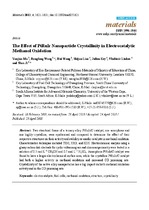| dc.contributor.author | Ma, Yanjiao | |
| dc.contributor.author | Wang, Rongfang | |
| dc.contributor.author | Wang, Hui | |
| dc.contributor.author | Liao, Shijun | |
| dc.contributor.author | Key, Julian | |
| dc.contributor.author | Linkov, Vladimir | |
| dc.contributor.author | Ji, Shan | |
| dc.date.accessioned | 2018-01-11T08:00:33Z | |
| dc.date.available | 2018-01-11T08:00:33Z | |
| dc.date.issued | 2013 | |
| dc.identifier.citation | Ma, Y. et al. (2013). The effect of PtRuIr nanoparticle crystallinity in electrocatalytic methanol oxidation. Materials, 6: 1621 - 1631 | en_US |
| dc.identifier.issn | 1996-1944 | |
| dc.identifier.uri | http://dx.doi.org/10.3390/ma6051621 | |
| dc.identifier.uri | http://hdl.handle.net/10566/3374 | |
| dc.description.abstract | Two structural forms of a ternary alloy PtRuIr/C catalyst, one amorphous and one highly crystalline, were synthesized and compared to determine the effect of their respective structures on their activity and stability as anodic catalysts in methanol oxidation. Characterization techniques included TEM, XRD, and EDX. Electrochemical analysis using a glassy carbon disk electrode for cyclic voltammogram and chronoamperometry were tested in a solution of 0.5 mol L−1 CH3OH and 0.5 mol L−1 H2SO4. Amorphous PtRuIr/C catalyst was found to have a larger electrochemical surface area, while the crystalline PtRuIr/C catalyst had both a higher activity in methanol oxidation and increased CO poisoning rate. Crystallinity of the active alloy nanoparticles has a big impact on both methanol oxidation activity and in the CO poisoning rate. | en_US |
| dc.language.iso | en | en_US |
| dc.publisher | MDPI | en_US |
| dc.subject | Electrocatalysts | en_US |
| dc.subject | Fuel cells | en_US |
| dc.subject | Methanol oxidation | en_US |
| dc.subject | Structure | en_US |
| dc.subject | Crystallinity | en_US |
| dc.title | The effect of PtRuIr nanoparticle crystallinity in electrocatalytic methanol oxidation | en_US |
| dc.type | Article | en_US |
| dc.privacy.showsubmitter | FALSE | |
| dc.status.ispeerreviewed | TRUE | |

